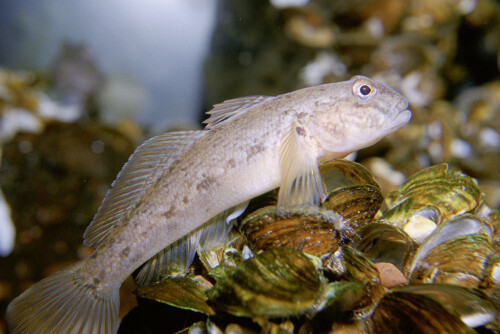Open Sky
For over an hour women had been arriving at the parish compound, most accompanied by children, and many carrying squash. They all wore traje but in various styles and colors. (The traditional white blouse and blue corte [skirt] of San Miguel Ixtahuacán are rarely used for everyday occasions, although later I would see them—and actually don them—during a noche cultural, an evening of performances for visiting antimining activists.) The women all greeted Hermana Maudilia, a nun who is, like all the women attending the meeting, Maya-Mam. The squash went to women already busy in the kitchen, for us to feast on later, while Maudilia tracked down incense and tuned her guitar. After helping set up benches in the cavernous hall of the sprawling church complex, I hung out in the sunny courtyard waiting for instructions from the Hermana. A small crowd gathered around the gringa, curious to know what I was doing there.
“Oh, you want to learn more about the mine? Well, you know someone was killed last week after the demonstration? I heard it on the radio.”
“The problem with the mine is when you hear there’s a child with a rash or a health problem, they go and pay so the people won’t say anything.”
“You’re from the States. My husband went there. Why should I lie? He left me for another woman. Now I have no way to feed my children.”
“The mine says, we don’t see any broken houses and if they do, they say it was falling apart before. It’s not their problem.”
“I sent my son to the US but there’s no work. We borrowed Q12,000 [about $1,500], but with interest it became Q60,000. I had to sell my 10 cuerdas of land to pay.”
Cutting into the flow of brief stories, each with its hook of embedded pain, Maudilia, smiling and gently insistent, began to urge us into the hall.
While I’d been outside, some women had arranged a beautiful mandala-like altar in the center of the room, with candles and flowers laid out on the floor. We launched into a song, but then realized there were too many people, so we laughingly reorganized the space for everyone to fit. By then, the two representatives of COPAE, the Catholic Church’s Peace and Ecology Commission, had arrived from the provincial capital of San Marcos, about three hours away by car (which, in turn, is over six hours by bus from the capital: San Miguel is rather isolated). Like many of the women, they’d gotten up around five AM to get to San Miguel for the meeting. While they set up their computer and projector near the altar, we kept singing.
Could it have been You who sent the miners?
They rape the womb of the Mother Earth
They take the gold, destroying the mountains
A gram of blood is worth more than a thousand kilos of gold.What is happening with my people?
And you, my God, where are you hiding?
Fear has paralyzed us
My people have been sold and we don’t even realize it.The water is drying up, it’s the same color as hell
The air we breathe is already polluted
We seek miracles, but it is too late
We seek to cure the sick and the mortally woundedA poor people are easy to buy
Gifts quiet suspicions and doubts
Paychecks disappear in the town’s cantinas
Homes grow dark and my people live dividedYou created a garden and not a desert
We want progress but with respect for the environment
Hunger for gold consumes more and more of the earth
And you, my God, you wonder
What are my people doing?
The song, created collectively by the parish’s choir, sets up some of the dubious biotechnological equivalencies I’ll examine in this essay—of blood to gold; of people to commodities that can be bought; of minerals to food and drink, both hungered for—and the disjuncture of progress to respect and to divisions in “my people.” In other words, life increasingly limited. The song itself was set to music by Padre Eric, the Belgian priest who has served San Miguel for 25 years. Most of the women seemed to know the words. After the music, volunteers approached the altar to lead prayers. We all knelt, and as they lit each candle in turn, we moved to face each of the four directions. Before the Columbus Quincentennial in 1992, such a thing would have been almost unthinkable in an official church activity, but pressure by Mayan activists for recognition of their spirituality within Catholic ceremony had opened space. While Padre Eric, who is fluent in Mam, and Monseñor Ramazzini, then Bishop of San Marcos, are very respectful of Mayan lifeways, it was Maudilia, the indigenous nun, who had introduced this form of prayer, and organized the monthly women’s meetings, like the one I was attending this July, 2009.
Then Maudilia introduced Vinicio and Teresa, the two ladino (nonindigenous) representatives of COPAE, and Vinicio began to explain why the church was trying to close the Canadian-owned gold mine that had opened in 2005, only a few miles away. Vinicio is a skilled and experienced organizer and spoke carefully so that women without much schooling, and working in their second language, could understand. But he did not patronize or oversimplify what neoliberal globalization meant in its local manifestation. 7 He first asked if they had questions and women quickly began to ask: “Is the water affected? Some say yes, others say no.” “People are getting sick.” “There are lots of conflicts.” “Why are they lying?” “They are killing the men.” “Can we drink out of our wells?”
Then he said, “Let’s talk about our country. It is little and we have had a war. 50,000 people were disappeared, we don’t know where they are. 200,000 people are dead. Why? It’s a problem with the land. You’ve worked on fincas (export crop plantations), you know how big they are: we say “a saber cuantas cuerdas” (who knows how many cuerdas?) but they aren’t even measured in cuerdas. 8 They are measured in bigger quantities: manzanas, hectáreas, caballerias, which are 1000 cuerdas. Ten caballerias is a finca, that’s 10,000 cuerdas. How much do your families have here? 12, 15? Maybe a few have 25. Some have only 3 or 5. This is what is called inequality. But why do they pressure us? Lie to us? Refuse to let us live in peace? Because they’re not content, even now. 70 percent of the population is poor. But you can go to the market and buy corn and beans. That’s because this is not a poor country. We produce. We are not poor because we are lazy. We are poor because the riches our country produces are concentrated in just a few hands. You’ve harvested coffee. You earn 10–15 quetzals a tarea (about $1.50–$2.00 per task or piecework), but if you are a woman, you only earn 5 to 10 for the same tarea.” The women seemed really with him, nodding. “And why aren’t there any schools in the villages? Schools that teach math and history? Because to harvest coffee you don’t need to study, you are just mano de obra (hands that work) and it’s better if mano de obra doesn’t know their rights, because then they might make demands. Guatemala has always exploited its people and resources. You go to the coast to harvest and you leave here strong but when you come back you and your children are sick.” The nodding became more emphatic. “In 1996 the war ended. But now there is a new exploitation, of what they call recursos naturales. The same small group that decides who will be the president and in the congress are also selling the mining licenses. Do you remember this mountain?”
With this, the Powerpoint® came on, projecting a picture of the mine and the whole atmosphere of the room was transformed. A wave of agitation coursed through the women. Some startled, drawing back, gripped by strong emotion. They whispered and pointed, a few stood up, others shifted uncomfortably, some had their hands to their mouths. Vinicio was drowned out by voices and the fluster of movement. Everyone was staring at the photograph. “The mountain is gone,” whispered the woman next to me. For a moment Vinicio tried to continue with his presentation, but then realized he needed to let the enormity of it sink in.
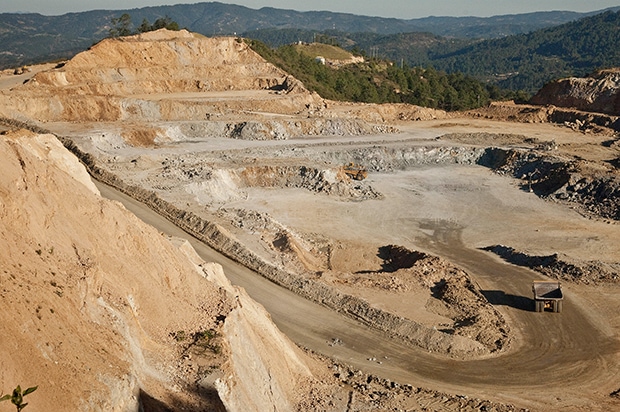
The Canadian mining company Goldcorp, through its subsidiary Montana Exploradora of Guatemala, is extracting ore at its Marlin mine through mountaintop removal, aka cielo abierto (open sky), or open pit mining. Several hundred meters in altitude are gone, leaving a broad slash of dun earth that looks like nothing so much as a scar. 9 Add to that the unearthly green of the large tailings lagoon, the cyanide-infused water stored in an open air pit that runs alongside, and the sight is pretty consternating, even for a gringa without a lifetime’s intimacy with the landscape.
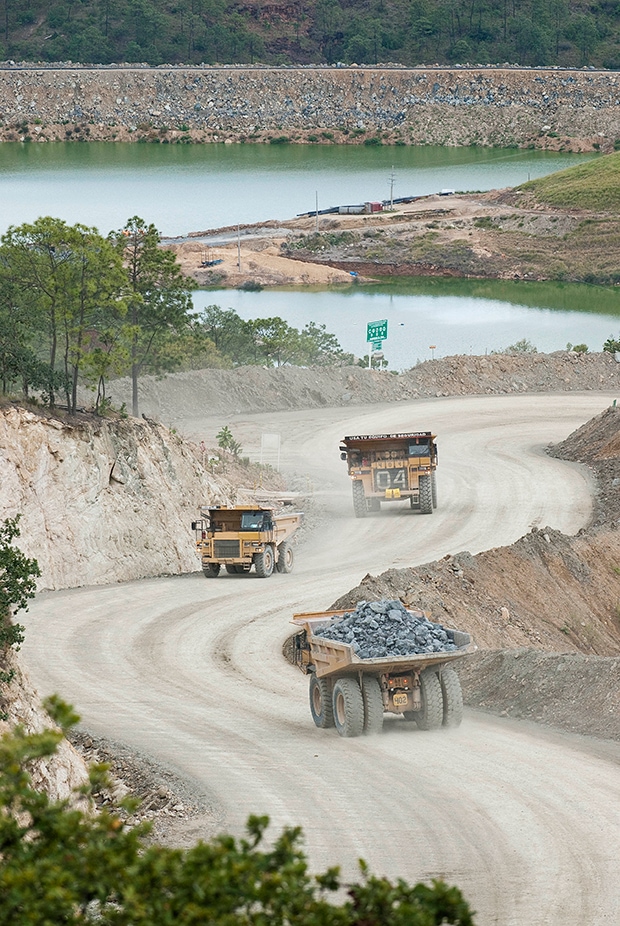
While Vinicio didn’t go into the details, perhaps you’d like to know a bit more how it works. To construct an open-air mine, all of the trees in the area are cut down, vegetation is scraped away, and the land is left denuded. Dynamite and heavy machinery expose the rocks containing the gold. The entire mountain is obliterated and the resulting pits can be several thousand feet deep and more than a mile wide. Tunnels are blasted even further down, which extend for several miles in every direction (often damaging surface structures like adobe houses).
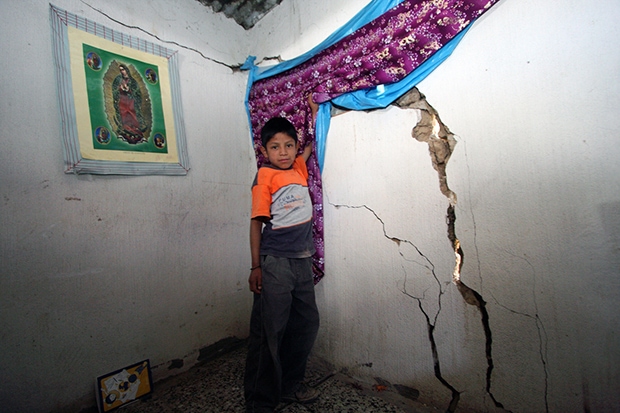
The ore is then flattened and soaked with a cyanide solution to leach out the gold. The gold-bearing cyanide solution is collected from the lined leach pad at the bottom of the heap and piped into a storage pond, then through a series of tanks where the gold collects onto activated carbon granules. The granules are then filtered out of the cyanide solution, which is returned to the heap. Gold is removed from the carbon by a hot, concentrated cyanide and alkali solution, and then passed through a tank where an electrical current plates the gold onto the cathodes. Finally, it is melted into gold doré and shipped to a refinery. 10 Helicopters ferry the gold and other precious metals from the San Miguel mine as the roads are considered too risky. A mountain will generally be depleted within six years, after which time the company is supposed to restore the area. 11 Thirteen years later, however, the Marlin mine is still going strong.
In San Marcos the concatenation of mountains, valleys, and roads make the mine, huge as it is, pretty invisible unless you live in the six hamlets right next to it. The week before, on my first trip to San Miguel in an old Toyota car, my friends and I had had a hard time even finding the unmarked turn onto the steep and twisty dirt road. After stopping to gaze in wonder at the scale of this human intervention into the ecosystem, we turned back less than a third of the way down, unsure the car would make it back (and intimidated by warnings about security goons). By their surprise reactions, it seemed that, while the women knew about the mine, they hadn’t really confronted its thereness. One turned to me and said, “Is it possible these people will leave?”
As we stared at the photographs, Vinicio said: “This is an industry. It is not a proyecto (a development project). It is an industry.” He would emphasize this throughout the talk because Goldcorp had been ramping up its public relations campaign. Dotting the road from San Marcos to San Miguel, along the Panamerican highway, and prominently placed just outside Guatemala’s international airport, were billboards with variations on the theme of “Lo valioso es el desarrollo” (What matters is development). One reads “We believe in a country that works with effort” (with a picture of a huge earth-moving truck), another “We share with the people of a country that doesn’t rest” (with a picture of the brightly-lit mining installations shining like a small city). “A mine with secure technology for human health and the environment, strengthening the integral development of San Miguel, industrial security,” says another, and “Community and Company working together for development.” 12 Another listed how much Montana was paying in taxes and royalties each year. It takes an Internet search, however, to discover that the Marlin mine is Goldcorps’s third-best performing investment in a global portfolio, with the lowest production costs in the world. It earned over $268 million in 2010. 13

The company’s development arm is its NGO, Sierra Madre (mother mountain). People debated how much Montana had actually invested in infrastructure, schools, roadwork, and the new hospital under construction in San Miguel (“life” technologies), but the company certainly claimed all these projects as its own, with big signs, and their trademark blue and green squiggle (meant to look like a range of mountains) painted on the sides of buildings and water pumps. The squiggle did not appear on the new Protestant churches in the villages near the mine, but the Catholics were sure that these, too, were paid for by the company. They also run frequent radio spots with actors saying things like, “I sell more in my shop now that Montana is here,” and sponsor full-page ads in newspapers contesting activists’ claims that the company is polluting water and harming humans. In June 2009, the company staged a march in San Miguel, with iconography borrowed from widely covered protests in the city against the social-democratic-leaning government. About 80 miners and their supporters, dressed all in white and carrying white roses (not native to the area, i.e., expensive), marched to the church with chants that accused Father Eric and Hermana Maudilia of trying to take away their jobs, of being against development, and even twisting classic protest songs like “No Basta Rezar” (It’s not enough to pray) to criticize the antimining politics of the diocese. In other words, the company and its supporters were aligning themselves with “life.” Less publicly, they deploy other tactics: Eric and Maudilia shrugged off the threatening phone calls they regularly receive, but during my stay, many local activists expressed fear of reprisals.
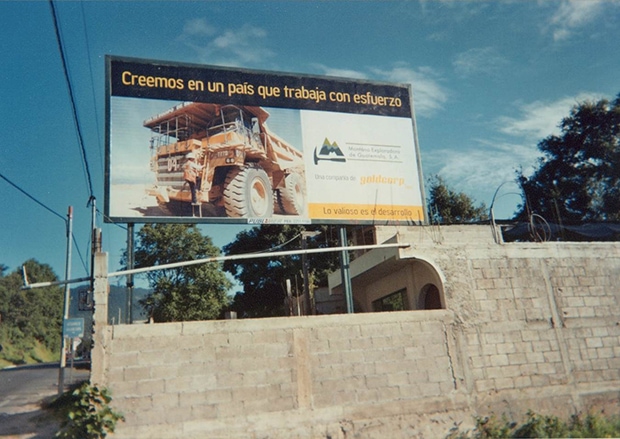
For example, at the demonstration of July 14 (after which the woman had said people died, a report I could not confirm), local antimining activist Aniseto López spoke to a crowd of about 1500 people in the central square of San Miguel. He works for the local grassroots development organization ADISMI, which has become a nodal point in the antimining movement. He greeted everyone in the Mam language and thanked the representatives from different areas for their solidarity. Then he switched to Spanish. “We have problems. We’ve been hit hard by the company. Our lives are threatened. We risk death. Four of our compañeras are being persecuted. They are mothers who are claiming their rights. It’s the state authorities, but behind them is Montana. But ánimo, friends. This is how we defend life. And we are defending it against a gigantic power, a global economic power. That’s why it’s not easy what we are doing. Talking against the mine you might end up dead. We get phone calls, death threats all the time. We’ve said goodbye to our families. We are ready to die.”
- The Guatemalan journal El Observador succinctly describes this process: “Characterized by the appropriation of lands and territories from indigenous communities to extract and exploit their natural resources, with the aim of generating high returns. These forms of accumulation are based on strategies energized by the world globalization wave that imposes a political and economic model based in deregulation, economic and financial liberalization, free trade, transnationalization and privatization of strategic services like infrastructure construction for large companies, telecommunications, generation and commercialization of electricity, and the loss of state influence as a social articulator and the subordination of democracy to private actors and interests.” Editorial, El Observador, 4.19 (June-July 2009): 2, my translation.[↑]
- One cuerda is 20 meters squared.[↑]
- Rainforest Action Network executive director Michael Brune, commenting on open sky coal mining in West Virginia (another poor mountainous place that was a laboratory for modernity) said, “I’ve seen oil spills in the Amazon, walked in clear-cuts so large they can be seen from outer space, and have toured some of the nastiest toxic waste dumps imaginable. But when it comes to complete and hopeless environmental devastation, nothing compares to a mountaintop removal site.” See “The Coalfield Uprising,” The Nation, 19 Oct. 2009, 289.12: 18. An open-pit mine opens James Cameron’s depiction of environmental catastrophe in Avatar.[↑]
- Condensed from Maria Van Der Maaten, “Changing Development Strategies in Rural El Salvador as a Result of Proposed Gold Mining,” M.A. Thesis, University of Colorado, n.d. 37-38.[↑]
- The company claims $1 million has been set aside for this purpose, while independent studies suggest a minimum of $49 million will be necessary for reclamation and monitoring. Of course, the mountain is never coming back.[↑]
- See also Katherine Fultz, “Explotando la quebrada: Género y sociedad en las publicidades corporativas,” paper presented at the VIII Congreso de Estudios Mayas, 2009. Creemos en un país que trabaja con esfuerzo and Compartimos con la gente de un país que no descansa (the slogans don’t make much sense in the original, either).[↑]
- Lyuba Zarsky and Leonardo Stanley, “Searching for Gold in the Highlands of Guatemala: Economic Benefits and Environmental Risks of the Marlin Mine,” (Medford: Global Development and Environment Institute Tufts U., 2011).[↑]


